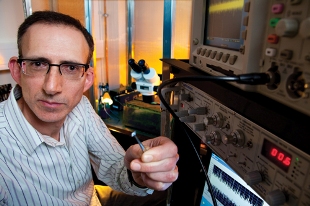Sep 10 2015
Using tiny “nanopore” scanners that can detect individual DNA molecules, Professor Amit Meller and colleagues are on the hunt for biological markers in cancer cells that may help clinicians diagnose colorectal and lung cancers at their earliest stages.
 Professor Amit Meller
Professor Amit Meller
Prof. Meller, of the Faculty of Biomedical Engineering at the Technion-Israel Institute of Technology, leads a research group that is a partner in BeyondSeq, an international research consortium looking for new methods of decoding genetic and epigenetic information from medical samples. BeyondSeq, supported by a €6 million grant from Horizon 2020, the European Union’s framework program, was one of only eight consortia chosen out of 450 submitted proposals.
“We are the only lab in the consortium working on early diagnosis of cancer biomarkers, which…will allow doctors to combat the cancers much more effectively and save human lives,” Meller explained. “Currently there are no good ways to diagnose colorectal cancer and lung cancer at early stages. Usually these cancers are diagnosed at later stage (stage 2 or above) in which the patients may already have multiple secondary tumors, hence highly complicating treatment.”
The nanopore technology developed by Meller and colleagues consists of tiny holes—about 100,000 times smaller than the thickness of a sheet of paper—drilled in ultra-thin silicon membranes. The researchers pass a current of electrically charged salt ions through the nanopore that attracts molecules such as DNA, which have their own natural electrical change, toward the pores. The DNA molecules are threaded through the pore and as they slide from one side of the membrane to the other, the pore acts as a scanner. Both optical and electrical signals given off as the molecule passes through the pore are detected providing information on the DNA properties, such as its length and sequence variations.
Meller said his team will be using the nanopores to looking at slight variations in the DNA nucleotides or “letters” that spell out the KRAS gene, which has already been identified as an important biomarker in colorectal and lung cancers. “We can encode the nucleotides variations in the KRAS gene with sets of color-emitting dyes and read the information with our nanopore sensor. We hope that our nanopore technology can be adapted for early detection, where the sensing of these biomarkers is currently extremely challenging and not accessible by conventional methods,” he said.
Nanopores could prove especially useful for early detection because they can scan very small amounts of molecules, uncovering the few cancerous cells or molecular markers of cancer in a large sample of healthy blood or tissue, he added.
The team is also developing a nanopore-based method to detect epigenetic modifications at the single-molecule level. Epigenetic modifications are chemical changes made to a DNA molecule. These chemical changes don’t alter the sequence of DNA letters that spells out a gene, but they can affect how the protein encoded by that gene is expressed inside a cell. (Some people have likened this difference to the markings on a musical score: think of the genetic sequence as the musical notes, while the epigenetic modifications are the instructions that tell a musician whether to play the note softly or loudly, for instance.)
Nanopores offer one way to see whether a piece of DNA has some of these epigenetic instructions attached to it, which could help scientists determine whether any of these instructions correlate to how a disease like cancer develops.
Meller and his colleagues have been developing the possibilities of nanopores for more than 15 years. In a paper published in Scientific Reports earlier this year, they demonstrated that the pores could detect the presence of a single transcription factor, a protein that activates the production of messenger RNA from the DNA.The pore’s scanning capabilities were even powerful enough to distinguish between two separate ways that the transcription factor could bind itself to the DNA, each with its own transcriptional effects.
In another paper published in Biophysical Journal, the researchers showed that the nanopore technology could detect different ways that proteins could be altered by another small protein called ubiquitin, which is responsible among other things to tag larger proteins for recycling by the cell. And in a third paper published in Nano Letters, Meller and his colleagues demonstrated that the nanopores can be used as optical scanners to read out a multicolored “barcode” engineered on DNA molecules.